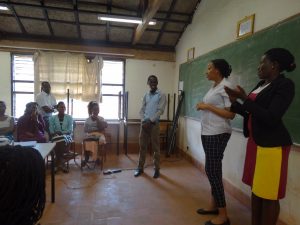Tackling inequalities through creation of digital sign language
SPIDER partners with UNAD to digitalise Ugandan Sign LanguageThis becomes more apparent as students in need of special accommodations go without their requirements being met, thus preventing them from accessing education. The new development agenda as reflected in the SDGs and the Africa Agenda 2063, specifically goal 4 (providing quality education for all) and goal 10 (reducing inequalities), cannot be reached unless we address disabilities, discrimination, and stigmatisation. Against this background, the Uganda National Association of the Deaf (UNAD) together with SPIDER entered into a two-year partnership to implement the “Digitalising Uganda Sign Language project.”.
Uganda Sign Language (USL) is an official language in Uganda and is an important component of the process of integrating Deaf people into the community. Approximately 1,200,000 people in Uganda use USL, and roughly 98% of them are Deaf.
The project combines research, user-centred design, and follow-up activities to develop content that meets the needs and aspirations of the different categories of learners such as Deaf children, teachers, health workers, police and family members, as well as sign-language instructors. The general objective is to elevate blended learning. UNAD builds on the wider partnership of key stakeholders from various sections including institutions of higher learning, government agencies, civil society organisations, Deaf people, sign-language experts, and service providers. It strives to galvanise efforts to ensure that the digital content for learning sign language is available, effectively utilised, and positively impacts Uganda’s Deaf community. There is insufficient data on people with disabilities, and this constrains international organisations’ ability to monitor improvement of the situation (as this report from UNESCO mentions). SPIDER is aware of this, and have reformed the SPIDER research programme for the period of 2015-2019. For more on the importance of inclusion, please read “Nothing about us without us” written by Edna Soomre, Head of SPIDER’s health programme.
SPIDER supports research institutions in partner countries by hiring local researchers, who know the languages and cultures, are aware of national and regional priorities, and are in a position to perceive situational nuances that foreign researchers might miss. Each SPIDER project has an integrated results follow up component that engages a local researcher to undertake periodic quality assurance measures or assessments in all stages of the project. This ensures the participation of the target groups, whose opinions and possible objections constitute valuable input to the ensuing stages of the implementation process.
In the case of UNAD, SPIDER works closely with Betty Najjemba, who is the Project Researcher. Betty has carried out a baseline study examining the level of ICT use and accessibility for sign language in Uganda’s various regions. This will help her and the team at UNAD in understanding the end-user experiences, expectations and the challenges in utilising Uganda’s digital sign-language content.
To learn more about the progress, lessons learned, and the way forward, please join SPIDER and UNAD at eLearning Africa on Thursday, September 28th, 12:15-13:00.



